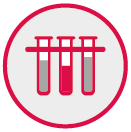OUR RESEARCH PROCESS
Research is at the heart of what we do and our research strategy outlines our intentions on achieving our mission. Our award winning research process ensures we only fund projects of the highest-quality that have the greatest chance of advancing our understanding of A-T, improving treatment and management, and accelerating benefits to patients.

1. Open Grant Round
We ask researchers to submit their ideas. These ideas can cover any aspect of A-T research.

2. Applications
Applicants create their research proposals and submit them to us for funding.

3. External Peer Review
Scientists and clinicians who are experts in the field or closely related field of the application are asked for their opinion. Strengths and weaknesses are assessed and written feedback provided.

4. Applicant Response
The reviewer remains anonymous to the applicant. Applicants are given the chance to read and respond to the scientific peer reviewers’ feedback answering any questions or providing clarification.

5. COE Review Meeting
Applications, external reviewer feedback, and the applicant’s responses are all discussed and considered by a review committee. The review committee is formed from members of the Action for A-T College of Experts (COE)
Members from the COE are selected from a pool of individuals to form a review committee. Individuals are selected to match the knowledge needed to review the applications submitted in that grant round. Each grant round, individuals are selected from the COE to form a bespoke committee. This ensures we have the specific expertise needed for the range of applications we receive; helps rotate the experts we use and promote different perspectives.

6. Final Decision
The COE recommend the strongest scientific applications to the board of Trustees who then make the final funding decisions. Successful applicants are notified and sent award letters.

7. Research
The best science and the best scientists are supported to gain new knowledge.

8. Monitoring Progress
All research projects are constantly monitored to check on progress. For further information visit our research monitoring page.


